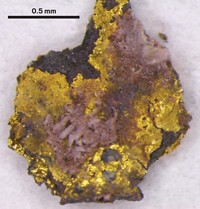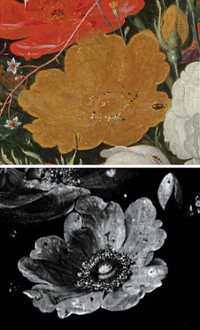Advertisement
Grab your lab coat. Let's get started
Welcome!
Welcome!
Create an account below to get 6 C&EN articles per month, receive newsletters and more - all free.
It seems this is your first time logging in online. Please enter the following information to continue.
As an ACS member you automatically get access to this site. All we need is few more details to create your reading experience.
Not you? Sign in with a different account.
Not you? Sign in with a different account.
ERROR 1
ERROR 1
ERROR 2
ERROR 2
ERROR 2
ERROR 2
ERROR 2
Password and Confirm password must match.
If you have an ACS member number, please enter it here so we can link this account to your membership. (optional)
ERROR 2
ACS values your privacy. By submitting your information, you are gaining access to C&EN and subscribing to our weekly newsletter. We use the information you provide to make your reading experience better, and we will never sell your data to third party members.
Biological Chemistry
For Cave’s Art, An Uncertain Future
Disagreement on conservation course of action complicates a potential reopening
by Carmen Drahl
October 24, 2011
| A version of this story appeared in
Volume 89, Issue 43

The cavern that houses Spain’s most celebrated prehistoric art is on the mend from a microbial infestation that closed it to the public. A push from regional government officials to reopen Altamira Cave to visitors has researchers who worked to improve its condition worried that their efforts will be undone (Science, DOI: 10.1126/science.1206788). But like the bacterial colonies dotting the storied cave’s walls, the scientific and ethical issues that will determine its fate are colored in shades of gray.

Nestled underground near a village in northern Spain, Altamira Cave contains astonishingly lifelike renderings of fawns, horses, and bison painted on its ceilings. The multicolored likenesses, more than 14,000 years old, are recognized as a pinnacle of Paleolithic rock art. The United Nations Educational, Scientific & Cultural Organization (UNESCO) declared Altamira Cave a World Heritage Site in 1985.
As Altamira became a tourist hub, ensuring its preservation became problematic. Officials closed the cave in the late 1970s, and then reopened it in 1982 to vastly reduced numbers of visitors. This limited schedule, however, wasn’t enough to keep the cave’s delicate ecosystem in balance. With bacteria encroaching on the paintings, officials closed the cave to the public in 2002. A team led by geologist Sergio Sánchez-Moral and microbiologist Cesáreo Sáiz-Jiménez of the Spanish National Research Council (CSIC) was tasked with cave cleanup and preservation.
“Caves are full of bacteria—that’s natural,” says Juan M. González-Grau, a CSIC researcher who studies Altamira’s microbes independently of Sáiz-Jiménez’ team. Only after the cave’s discovery did large, potentially problematic colonies emerge at Altamira, he says.
Microbes’ chemistry makes them more than an aesthetic threat to rock art, Sáiz-Jiménez explains. His team has uncovered multiple microbial strains in Altamira Cave in colors including gray, yellow, and white. In addition, the photosynthetic bacteria that are considered to be one of the cave’s biggest threats leave green stains on the walls. Attempts to remove invaders could strip precious paintings away with them, he says.
Microbes can even compromise cave walls, says Flinders University research associate Eric M. Adetutu, who is studying humans’ impact on Australian caves. Some microbes grow as biofilms using inorganic materials from cave walls for nutrients, which could lead to mechanical stresses and even fracturing of rock surfaces, he says. González-Grau’s tests in Altamira have turned up those types of bacterial communities. The microbes can vary the pH of Altamira’s calcium carbonate walls, which could dissolve walls or coat them with new deposits (Curr. Microbiol., DOI: 10.1007/s00284-009-9561-1).
Since 2002, CSIC has worked to control environmental qualities that could allow microbes to thrive, Sáiz-Jiménez says. His team has removed grasses and curtailed cattle-grazing activity in land above the cave, which could feed cave microbes below by enriching groundwater with nutrients. They’ve also installed doors to prevent an influx of airborne spores and food sources, and they’ve removed the artificial lighting that photosynthetic bacteria use to make food. These actions have visibly shrunken the green stains on the cave walls, Sáiz-Jiménez says.
The council’s scientific approach is not free of critics. For instance, Sáiz-Jiménez’ report that fungi also threaten Altamira has proven controversial (Naturwissenschaften, DOI: 10.1007/s00114-009-0561-6). Evidence from González-Grau’s lab suggests that spiders, which would not be as big a threat as fungi, could also produce the filaments Sáiz-Jiménez attributed to fungi (Naturwissenschaften, DOI: 10.1007/s00114-009-0632-8). Sáiz-Jiménez stands by his team’s work, saying that DNA tests also pointed to the presence of fungi.
But Robert J. Koestler, director of the Smithsonian’s Museum Conservation Institute and a member of a scientific commission for France’s famed Lascaux Cave, says the team hasn’t been using the most accurate genetic methods for identifying organisms, which leaves tiny invaders’ identities unclear.
Altamira Cave’s board of directors has called for a new scientific commission to evaluate whether the site should be reopened and, if so, with what restrictions. Aitana Mauleón, a spokeswoman at the Spanish Ministry of Culture, which owns the cave site, says that the CSIC scientists’ advice will be among several factors weighed at the board meeting this November. The regional Spanish government, which has pushed for the cave’s reopening, did not respond to C&EN’s requests for comment.
The cave’s fate doesn’t rest with scientists, González-Grau says. “Scientists present some facts, and on the basis of that some other people will have to decide what to do.”
The scientific consensus is that with the microbial presence in its current state, the cave shouldn’t be reopened. The question of whether more could, or should, be done to make visits viable is thornier.
“I think it’s better to be safe than sorry when it comes to conserving cave art because once damaged it is difficult to restore,” Flinders’ Adetutu says. “With proper management it’s possible for people to visit some caves but not all.”
Not every scientist agrees with the better-safe-than-sorry philosophy. Francesca Cappitelli, who studies cultural heritage microbiology at the University of Milan, thinks CSIC’s analysis of the cave is sound. Nevertheless, she says, before advocating a complete shutdown of the cave, “I would have expected CSIC to make more attempts to apply newly available preventive procedures.”
Complete cave closures “should be intended as a temporary solution until scientific advances come along that could help address the problem in a different way,” Cappitelli says. A permanent closure could have unintended consequences, such as funding cuts, which would undermine the very conservation intended in the first place, she adds.
“I praise the team for what they have done,” adds Koestler. “But they’ve overlooked some things that should be done” to beat back microbes further, including installing air filters and carefully testing biocides, he says. He thinks such measures applied properly could keep the cave safely preserved while allowing in small numbers of visitors.
“A single visitor, even a scientist studying the cave, produces a negative impact,” counters Sáiz-Jiménez. Computer models of visitation periods in the 1990s suggest that visitors to Altamira temporarily warm its air and alter humidity and carbon dioxide levels, which could facilitate microbial growth. Walking sends spores airborne, spreading colonies to new locations, he adds.
What’s more, “the lessons from Lascaux are that industrial biocides cannot be applied to a cave,” Sáiz-Jiménez says. Attempts to use a biocide called benzalkonium chloride at Lascaux failed to curb the fungal infestation in that cave.
“Tourists do not visit the cave for study, just for fun, and for this purpose there is a replica cave” on the same site, Sáiz-Jiménez says. For students and scholars “huge amounts of pictures, documents, and studies can be accessed.”
Koestler notes that the infestation at Altamira is different from that at Lascaux, so it might be possible to find a different type of chemical agent to control Altamira’s microbes without harming paintings or cave walls. It’s also possible the cave could be illuminated for visitors with lighting that tunes out the wavelengths photosynthetic bacteria use to make their food, he adds.
“This cave is so beautiful. It represents such a fascinating stage of human existence and development,” Koestler says. “People should see it. They should have access to it to fully understand its context.” ◾





Join the conversation
Contact the reporter
Submit a Letter to the Editor for publication
Engage with us on Twitter